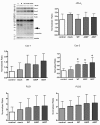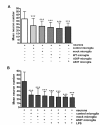Expression of mutant alpha-synuclein modulates microglial phenotype in vitro
- PMID: 21554732
- PMCID: PMC3104357
- DOI: 10.1186/1742-2094-8-44
Expression of mutant alpha-synuclein modulates microglial phenotype in vitro
Abstract
Background: Increased reactive microglia are a histological characteristic of Parkinson's disease (PD) brains, positively correlating with levels of deposited α-synuclein protein. This suggests that microglial-mediated inflammatory events may contribute to disease pathophysiology. Mutations in the gene coding for α-synuclein lead to a familial form of PD. Based upon our prior findings that α-synuclein expression regulates microglial phenotype we hypothesized that expression of mutant forms of the protein may contribute to the reactive microgliosis characteristic of PD brains.
Methods: To quantify the effects of wild type and mutant α-synuclein over-expression on microglial phenotype a murine microglial cell line, BV2, was transiently transfected to express human wild type (WT), and mutant α-synuclein (A30P and A53T) proteins. Transfected cells were used to assess changes in microglia phenotype via Western blot analysis, ELISA, phagocytosis, and neurotoxicity assays.
Results: As expected, over-expression of α-synuclein induced a reactive phenotype in the transfected cells. Expression of α-synuclein increased protein levels of cycloxygenase-2 (Cox-2). Transfected cells demonstrated increased secretion of the proinflammatory cytokines, tumor necrosis factor-α (TNF-α) and interleukin-6 (IL-6), as well as increased nitric oxide production. Transfected cells also had impaired phagocytic ability correlating with decreased protein levels of lysosomal-associated membrane protein 1 (LAMP-1). In spite of the increased cytokine secretion profile, the transfected cells did not exhibit increased neurotoxic ability above control non-transfected BV2 cells in neuron-microglia co-cultures.
Conclusions: These data demonstrated that over-expression of α-synuclein drives microglial cells into a form of reactive phenotype characterized by elevated levels of arachidonic acid metabolizing enzymes, cytokine secretion, and reactive nitrogen species secretion all superimposed upon impaired phagocytic potential.
Figures





Similar articles
-
Alpha-Synuclein Proteins Promote Pro-Inflammatory Cascades in Microglia: Stronger Effects of the A53T Mutant.PLoS One. 2016 Sep 13;11(9):e0162717. doi: 10.1371/journal.pone.0162717. eCollection 2016. PLoS One. 2016. PMID: 27622765 Free PMC article.
-
Alpha-synuclein expression modulates microglial activation phenotype.J Neurosci. 2006 Oct 11;26(41):10558-63. doi: 10.1523/JNEUROSCI.1799-06.2006. J Neurosci. 2006. PMID: 17035541 Free PMC article.
-
TREM2 signaling in Parkinson's disease: Regulation of microglial function and α-synuclein pathology.Int Immunopharmacol. 2024 Dec 25;143(Pt 2):113446. doi: 10.1016/j.intimp.2024.113446. Epub 2024 Oct 29. Int Immunopharmacol. 2024. PMID: 39490141
-
Pathological α-synuclein exacerbates the progression of Parkinson's disease through microglial activation.Toxicol Lett. 2017 Jan 4;265:30-37. doi: 10.1016/j.toxlet.2016.11.002. Epub 2016 Nov 16. Toxicol Lett. 2017. PMID: 27865851 Review.
-
Role of α-synuclein in microglia: autophagy and phagocytosis balance neuroinflammation in Parkinson's disease.Inflamm Res. 2023 Mar;72(3):443-462. doi: 10.1007/s00011-022-01676-x. Epub 2023 Jan 4. Inflamm Res. 2023. PMID: 36598534 Review.
Cited by
-
Studies of lipopolysaccharide effects on the induction of α-synuclein pathology by exogenous fibrils in transgenic mice.Mol Neurodegener. 2015 Jul 30;10:32. doi: 10.1186/s13024-015-0029-4. Mol Neurodegener. 2015. PMID: 26223783 Free PMC article.
-
The role of microglia in the development of neurodegeneration.Neurol Sci. 2020 Dec;41(12):3609-3615. doi: 10.1007/s10072-020-04468-5. Epub 2020 May 26. Neurol Sci. 2020. PMID: 32458252 Review.
-
Apocynin prevents mitochondrial burdens, microglial activation, and pro-apoptosis induced by a toxic dose of methamphetamine in the striatum of mice via inhibition of p47phox activation by ERK.J Neuroinflammation. 2016 Jan 18;13:12. doi: 10.1186/s12974-016-0478-x. J Neuroinflammation. 2016. PMID: 26780950 Free PMC article.
-
Advancements in Targeting Macrophage Senescence for Age-Associated Conditions.Aging Dis. 2024 Sep 14;16(4):2201-2236. doi: 10.14336/AD.2024.0720. Aging Dis. 2024. PMID: 39500353 Free PMC article. Review.
-
Targeting Microglial Activation States as a Therapeutic Avenue in Parkinson's Disease.Front Aging Neurosci. 2017 Jun 8;9:176. doi: 10.3389/fnagi.2017.00176. eCollection 2017. Front Aging Neurosci. 2017. PMID: 28642697 Free PMC article. Review.
References
-
- Fischer HG, Reichmann G. Brain dendritic cells and macrophages/microglia in central nervous system inflammation. J Immunol. 2001;166:2717–26. - PubMed
Publication types
MeSH terms
Substances
Grants and funding
LinkOut - more resources
Full Text Sources
Other Literature Sources
Research Materials
Miscellaneous

